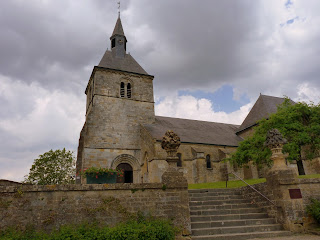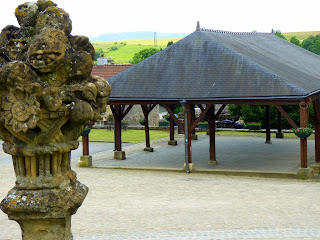Venoy (Auxerre)-(Vezelay) Pontaubert
After a wet
night the weather is sunny again and beautiful. We have breakfast in the main
building of the hotel and go on our way. It would be very tempting to stay here
a bit longer and explore the area, but we have to move on. We skirt Auxerre,
perhaps not very wise as it seems to be a charming town with a lot of history and
a very old centre. The St. Etienne is one of the most important gothic
cathedrals of Burgundy and the Abbeye de St. Germain in roman-gothic style
houses in its crypt the oldest murals in France, dating back to the 9th
century. So I have to go back some time. But as our goal is Vezelay, we move on
and follow the attractive banks of the river Yonne.
Cravant
Cravant
Gate of the town - Cravant
We stop in
Cravant, a gem of a walled town where the river Cure joins the Yonne. Here we
walk around, buy sandwiches in a baker's shop which we eat in the park around
the church. The town is built up against the hills and has all the ingredients
of historic towns in this part of France: town gates, a lime tree walk, a big
church, a covered wash house where the women could do the laundry, a "Tour
de Horloge" higher up in the town, a Mairie facing a square, a covered
market place, flowers decorating walls of golden stone, big doors and shutters
with pastel coloured peeling paint. It is a delight to wander around. But we
have to go on.
Wash place
Picturesque Cravant
We turn off
the road to explore an old abbey in the meadows down by the river, but are disappointed
as it turns out to be privately owned now and has a restaurant where people seem
to enjoy either lunch in their Sunday best or are having a party. The rest of
the buildings is closed to the public, including the former chapel. At least
the buildings are still there.
Asquins
View of Vezelay Abbey from Asquins
Coquille de St. Jacques
Murals in the sacristy - Asquins
Just before
Vezelay we see a small village church in Asquins, high on a hill. We drive up
through the narrow streets to get a better look at it. From here we have a
splendid view of Vezelay and the Abbey. The church, built in this high position,
seems a modest village church. An old lady sitting quietly in the back tells us
that in fact the pilgrimage to Compostella starts from this church and not from
Vezelay Abbey. There are two statues of St. Jacques, and a brass shell outside
guides the pilgrims on their way. It is a very interesting church, with murals
on the walls. The woman opens the door of the sacristy for us en shows us some
more murals. In fact the church is a very peaceful place, a place where it
would be easy to pray, or to be blessed before being sent on a mission. It is
simple, humble in a way, which is far more fitting for the life of a pilgrim
than the big cathedrals. They may fill one with awe, but they are not on a
human scale. Too grand for simple human beings, however beautiful they may be. When
we walk back we notice that one of the picturesque houses with a view of the
church is for rent as a holiday home. Not a bad place to stay!
St. Jacques
Asquins - side door of the church
And then it
is only a short drive to Vezelay, down the village, through the valley up
towards the town. Destination reached, the satnav would say. And indeed we have
reached what we set out to reach, Vezelay. We park the car, walk up through the
main street to the Abbey and I have my first look of a church I have heard so
much about. The tympanum is amazing, the one outside as well as the one inside
in the hall before entering the nave of the church. We spend quite a lot of
time here. The abbey is wonderful with its black and white blocked roman arches,
the architraves and the tympanums chiselled in great detail, the light fascinating.
The choir is gothic, in contrast to the nave. It is amazing that people have
been able as well as willing to build such cathedrals, for this is a splendid
example, but still one of many others, scattered over western Europe.
We also
walk around the abbey, admiring the views from this high point, and spot the
small church in Asquins we just visited, also on a hill but a much lower one
appropriate to its size.
Vezelay
View of the church at Asquins from Vezelay
Finally it
is time to make our way to our hotel for the coming two nights, in Pontaubert on
the road from Vezelay to Avallon, the latter another historic town where we
have a meal.
Avallon, church entrance
Ramparts of Avallon high above the river Cousin




















































